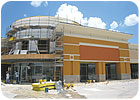

In residential construction, single-family homes, there are very few rules about adding decorative foam shapes to exterior walls. Simply, foam plastic shall have a flame spread rating of not more than 75 and smoke-develop rating of not more than 450 when tested in the maximum thickness intended for use per ASTM E-84 per the 2006 International Residential Code (IRC) section R314. The IRC also states that decorative foam trim shall not be face nailed through the Exterior Insulated Finish System (EIFS), section R 703.9.
For all buildings falling under the International Building Code (IBC), there are a few more rules, but the code does allow exterior walls to be covered with foam. For example, cold storage facilities that are required to be “non-combustible” may be covered on the exterior with foam plastic, provided they meet certain code provisions.
The first and most critical item is to stay below the “potential heat source” or fuel source as set by the National Fire Protection Association in NFPA 285. The potential heat source is expressed in British Thermal Units (BTU’s) and the maximum BTU shall not exceed 6,000 BTU in a square foot when tested per NFPA 259 and in accordance with NFPA 285 (IBC section 2603.5.3). This generally translates to four inches or less of foam plastic sheathing on exterior walls, provided the flame spread index of the foam plastic does not exceed 25 and has a smoke-develop index of less than 450. Check with the foam manufacturer for details.
Many designers and inspectors have been concerned that a large decorative foam plastic cornice over 4 inches thick appears to violate the code. However, looking at the bigger picture, the “fuel source” of the foam shape may not violate the code. Type I buildings (the most fire-restrictive) allow foam plastic with restrictions. The other consideration is the fire-resistant membrane beneath the foam plastic. Codes allow foam plastics on the exterior of the building provided the fire resistant membrane is provided as a thermal barrier. Typically 5/8-inch type X gypsum sheathing or a 7/8-inch portland cement plaster are sufficient to provide this required thermal barrier.





Report Abusive Comment